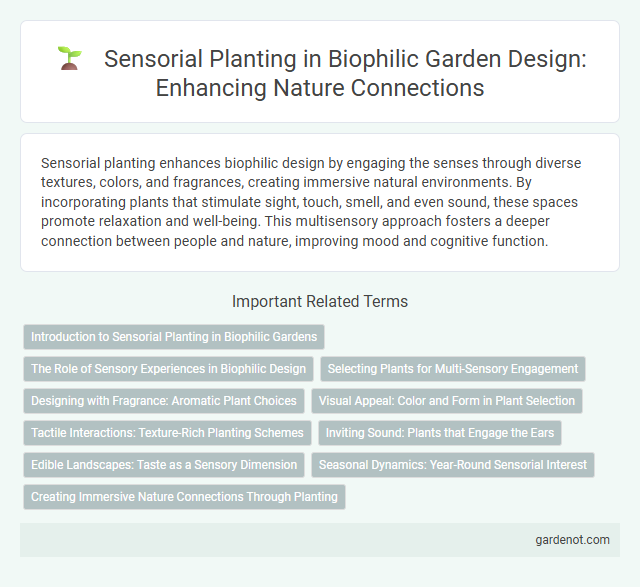Sensorial planting enhances biophilic design by engaging the senses through diverse textures, colors, and fragrances, creating immersive natural environments. By incorporating plants that stimulate sight, touch, smell, and even sound, these spaces promote relaxation and well-being. This multisensory approach fosters a deeper connection between people and nature, improving mood and cognitive function.
Introduction to Sensorial Planting in Biophilic Gardens
Sensorial planting in biophilic gardens enhances human connection to nature through carefully selected plants that engage all five senses--sight, smell, touch, sound, and taste. This approach incorporates diverse textures, fragrances, colors, and natural sounds to stimulate sensory experiences and promote well-being. By integrating native species and seasonal variations, sensorial planting supports biodiversity while creating immersive, restorative outdoor environments.
The Role of Sensory Experiences in Biophilic Design
Sensorial planting enhances biophilic design by engaging multiple senses through diverse textures, colors, and scents, creating immersive natural environments. This multisensory approach promotes psychological well-being, reduces stress, and improves cognitive function by fostering deeper connections with nature. Integrating tactile leaves, fragrant flowers, and rustling foliage intensifies sensory stimulation, reinforcing the restorative effects of biophilic spaces.
Selecting Plants for Multi-Sensory Engagement
Selecting plants for multi-sensory engagement in biophilic design involves choosing species that stimulate sight, smell, touch, and sound to create immersive natural experiences. Plants like lavender and jasmine provide aromatic scents, while textured foliage such as lamb's ear invites tactile interaction, and grasses like miscanthus produce rustling sounds in the wind. Incorporating a diverse palette of colors, fragrances, and textures enhances sensory richness and supports emotional well-being in indoor and outdoor environments.
Designing with Fragrance: Aromatic Plant Choices
Incorporating aromatic plant choices in biophilic design enhances the sensorial experience by engaging the olfactory senses and creating emotional connections to natural spaces. Plants such as lavender, rosemary, jasmine, and eucalyptus are versatile options that provide soothing or invigorating fragrances while supporting biodiversity and air quality. Strategic placement of these aromatic plants in indoor and outdoor environments promotes wellness, reduces stress, and fosters a deeper connection between occupants and nature.
Visual Appeal: Color and Form in Plant Selection
Sensorial planting in biophilic design emphasizes visual appeal through strategic color and form selection, using a diverse palette of vibrant foliage and blossoms to create dynamic and engaging spaces. Incorporating varied shapes, such as broad leaves, delicate ferns, and sculptural succulents, enhances texture and depth, fostering a strong connection to nature. Prioritizing high-contrast colors and organic patterns supports mood elevation and visual interest, crucial for well-being in interior and exterior environments.
Tactile Interactions: Texture-Rich Planting Schemes
Sensorial planting in biophilic design emphasizes tactile interactions through texture-rich planting schemes that engage touch and enhance user experience. Incorporating diverse foliage textures, from velvety lamb's ear to spiky ornamental grasses, creates dynamic surfaces inviting physical contact and sensory exploration. These varied textures not only stimulate touch but also contribute to emotional well-being by fostering a deeper connection between people and nature within indoor and outdoor environments.
Inviting Sound: Plants that Engage the Ears
Sensorial planting in biophilic design includes plants that produce inviting sounds, such as rustling leaves or gentle seed pod rattling, to enhance auditory connection with nature. Species like bamboo, ornamental grasses, and eucalyptus create soothing natural soundscapes that promote relaxation and well-being. Incorporating sound-producing plants strategically enriches outdoor and indoor environments by engaging the ears alongside visual and tactile senses.
Edible Landscapes: Taste as a Sensory Dimension
Edible landscapes integrate sensorial planting by engaging taste as a crucial sensory dimension, enhancing the biophilic design experience. Incorporating herbs, fruits, and vegetables into outdoor and indoor green spaces not only supports sustainability but also fosters direct interaction between humans and nature. This sensory engagement through taste strengthens emotional well-being and deepens the connection to natural environments.
Seasonal Dynamics: Year-Round Sensorial Interest
Sensorial planting in biophilic design harnesses seasonal dynamics to maintain year-round sensorial interest through diverse textures, colors, and scents that evolve with the changing seasons. Incorporating native flora such as flowering perennials, deciduous trees, and aromatic herbs ensures continuous engagement of sight, smell, and touch across spring, summer, fall, and winter. Strategic layering of plants with staggered bloom times and varying foliage characteristics maximizes sensory stimulation and emotional well-being throughout the entire year.
Creating Immersive Nature Connections Through Planting
Sensorial planting in biophilic design enhances immersive nature connections by engaging multiple senses through diverse plant textures, colors, and scents. Incorporating fragrant herbs, tactile foliage, and visually dynamic flowers stimulates emotional and cognitive responses that deepen human-nature interaction. This multisensory approach fosters wellbeing by creating calming, restorative environments that mimic natural ecosystems.
Sensorial planting Infographic

 gardenot.com
gardenot.com